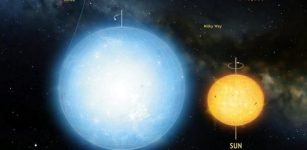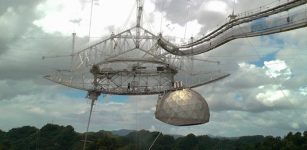How Gravitational Waves And ‘Multi-Messenger’ Research Will Change Astronomy
MessageToEagle.com – Scientists announced Monday (Oct. 16) that the era of multi-messenger astronomy has officially begun. But what does that phrase mean, and how will it change the study of the cosmos?
This is the first time scientists have seen gravitational waves and light waves from the same event. Studying the universe with these two fundamentally different types of information is like observing the world with multiple types of sensory input, such as vision and hearing — it offers the possibility of a richer understanding of the world, researchers said. [When Neutron Stars Collide! What the Hubble Telescope and Others Saw (Videos)]
“This is the first time the cosmos has provided for us what I would call a talking movie,” said David Reitze, executive director of the LIGO laboratory, at a news conference yesterday. “We’ve moved from the era of silent movies to talking movies. In this case, the audio soundtrack comes from the [gravitational wave] ‘chirp’ of the neutron stars … as they are orbiting together and colliding. And the video is basically the light that we see after the collision.”
Laura Cadonati, deputy spokesperson for the LIGO Scientific Collaboration, who also spoke at the news conference, used a similar analogy when describing what it is like for astronomers to look at the universe with only light, compared to the combination of light and gravitational waves.
“To me, this is equivalent to the transition from looking at a black-and-white picture of a volcano to sitting in an IMAX 3D movie that shows the explosion of Mount Vesuvius,” Cadonati said. “[In the 3D movie], you are surrounded by the flashes of light, and engulfed in the sounds of the volcano fury.”
An unremarkable event
The neutron star collision was first detected by the Laser Interferometer Gravitational-wave Observatory (LIGO) — which made the first-ever direct detection of gravitational waves in 2015 — and the Virgo gravitational wave observatory, which made its first detection of gravitational waves earlier in August.
LIGO and Virgo, on the other hand, can identify the types of objects creating the gravitational wave signals these instruments detect. Multiple scientists said that the GRB associated with the Aug. 17 neutron star merger was not particularly noteworthy by itself, and there was no special reason for other astronomers to go and observe it in different wavelengths. It was only because of the gravitational wave signal that other observatories looked at this event, discovering a treasure trove of data.
Among the major scientific findings that have been reported thus far, two major results stand out. First, that this is the first direct observation of a double neutron star merger, and the observations have confirmed that these events produce elements heavier than lead, including things like platinum and gold. Second, observations of the event also confirmed that neutron star mergers produce gamma-ray bursts (GRBs), a hypothesis that was as-yet unconfirmed, according to Julie McEnery, Fermi project scientist, who spoke during the news conference.
The joint observations by both the light-based and gravitational-wave-based observatories have “revealed details that we’ve never seen before in any astronomical events,” according to Nial Tanvir, a professor of astrophysics at the University of Leicester, who spoke at the news conference. Tanvir, who studies neutron stars, said he and his colleagues will continue to study the data from this event for months or perhaps even years.
Jim Ulvestad, acting assistant director for mathematical and physical sciences at the National Science Foundation, said that “dozens, if not hundreds” of scientific papers have already been submitted or will soon be submitted for publication based on the observations of the event.
“Everybody up here should be incredibly grateful to the gravitational wave astronomers,” said Ryan Foley, and assistant professor of astronomy and astrophysics at the University of California, Santa Cruz, said of his fellow scientists at the news conference. “This was an amazing gift. We learned a lot about the universe.”
Everyone stopped to look
The level of attention given to the Aug. 17 event by the international astronomical community illustrates the impact of this multi-messenger observation.
In total, 70 observatories have reported making observations of the Aug. 17 event. Those observatories are spread across all seven continents (including Antarctica) and in space; they also cover every wavelength range, including radio, infrared, visible, ultraviolet, X-ray and gamma-ray. An overview paper describing the main results from these light-based observations, published in The Astrophysical Journal Letters, cites 3,500 authors.
“It was the astronomical equivalent of stopping traffic,” Andy Howell, a staff scientist at Las Cumbres Observatory and a co-author on a paper about the neutron star merger, said during the news conference. “We all stopped to go and get a look.”
The European Southern Observatory, which manages more than a dozen telescopes in the Southern Hemisphere, made significant observations of the Aug. 14 event with “no fewer than 14 different instruments on 10 different telescopes,” Tanvir said.
“We think that makes it the largest and most complicated campaign of astronomical follow-up that’s ever been conducted, and certainly over such a short period of time,” he said.
Both LIGO and Virgo are currently undergoing upgrades that will further increase their sensitivity (and thus the total volume of sky they are able to search), which should increase the number of events they detect. Some of the researchers at the news conference said they anticipate that even more telescopes will take the opportunity to observe these events.
“I think our anticipation is that there will be many more events in the future … which is both extremely rewarding to think about and [also] terrifying, given all the effort that has gone into this one event,” said Edo Berger, a professor of astronomy at Harvard University. “I think there will be more people joining this party.”
MessageToEagle.com via Space.com
This article was originally published on Space.com – the leading space news site on the web keeping up on the latest space science, technology and astronomy news.













